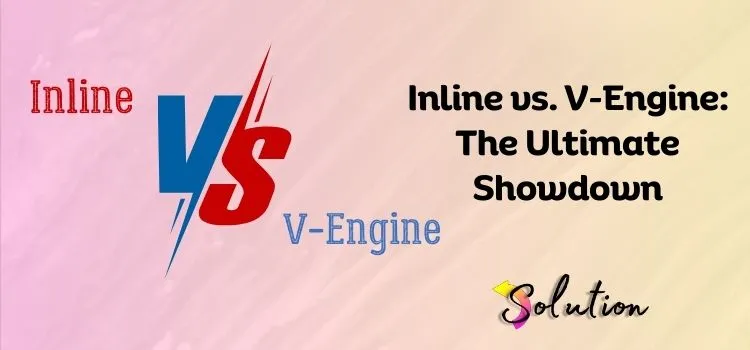
Vroom vroom 🏎️💨
It’s not just a sound—it’s the heart of your dream machine. Let’s rev the engine to high RPM.
Imagine this: You entered one of the showrooms of your favorite car company, whether it may be Bentley, Land Rover, or Mercedes. You gaze at the stunning luxury cars; you filter out two or three cars to bring to your home, but the salesperson throws around some technical jargon like horsepower, torque, and cylinders. Immediately, he gestures to two cars, stating that one has an inline engine and the other has a V-engine.
Confused… Ah, the ugly feeling!
Being a car enthusiast, we never even try to fall deeply in love with the technical jargon. At that time, we all aspired to own a powerful car that would respond quickly when we applied more pressure to the pedal. But as the time comes to convert your dream into a reality, most of us often get confused about which engine option to choose, i.e., inline or V-engine.
Both engines are powerful and smooth and offer different advantages depending on the type of driving experience you are looking for. Some high-performance cars are supported by a V engine, whereas cars are built with the simplicity of an inline engine.
So, if you’re a true petrol car lover and want to understand the difference between these two engines, then it’s time to wear your seatbelt. We’re about to embark on an exhilarating journey where you’ll gain a comprehensive understanding of the two iconic engine configurations, namely the inline and V engines, enabling you to decide which one truly deserves the title!
Let’s hit the RPM to its max and see who is going to win the race.
Inline Engines: Smoothness with Low Maintenance
An inline engine, also known as a straight engine, is one of the most common engine configurations used in cars, motorcycles, and even some trucks. This engine is defined by the linear arrangement of its cylinders, which means all pistons move up and down in a single straight line.
These engines are popular for their straightforward design, efficiency, and ease of maintenance. Whether it’s an Inline-4 powering an economical car or an SUV featuring an Inline-6 powerful engine, this powerful engine configuration has proven to be reliable and versatile.
Inline engines are commonly placed in the front engine bay, but in high-performance or sports cars, they are positioned longitudinally, from front to back for better weight management. Most common variations in the inline engines are Inline-3 (I3), Inline-4 (I4), Inline-5 (I5), Inline-6 (I6), and Inline-8 (I8). The numbers 3, 4, 5, 6, or 8 reflect the number of cylinders in the engine, with each configuration offering different levels of power and performance.
An inline engine typically converts fuel into mechanical power through a precise sequence of events inside its cylinders. This is known as the internal combustion process, which happens in four stages: intake, compression, power, and exhaust, also called the four-stroke cycle.
V Engines: Time for Fly-Bye
The first word that comes to mind when hearing about a V engine car is “roaring”—a powerful machine that dominates the road due to its performance, power, and speed.
Unlike inline engines, where cylinders are arranged in a straight line, a V engine has cylinders arranged in a V shape. They typically occupy a 60° or 90° angle and come in cylinder counts of 6, 8, 10, or 12. With a shorter and more compact engine, it makes it possible to fit more cylinders. Two cylinders are facing each other in the V-shaped engine, which allows for more efficient airflow and combustion.
V6 engines are found in mid-size cars, and V8 is commonly utilized in all of our most favorite sports cars, like the Ford Mustang, BMW M5, and Dodge Challenger. Right the moment you hit the pedal, you will instantly feel the power and acceleration that a V8 engine can deliver.
Supercars and ultra-premium luxury cars use V10 and V12 as additional options, offering extreme power and smoothness.
Power vs. Acceleration vs. Efficiency: Which Engine Suits Your Driving Style?
Selecting between an inline and V engine is more than just a haphazard decision. It’s about selecting an engine that goes best with your driving style. Especially if you are someone who craves power, loves quick acceleration, or wants maximum fuel efficiency, it’s important to carefully consider the pros and cons of each engine type. Let’s break it down simply into three major prospects, i.e., power, acceleration, and efficiency.
Power: The Heart of Performance
If big numbers of horsepower and torque excite you, then V engines are your go-to choice. Packed with more cylinders, these engines are capable of delivering high levels of power, making them ideal for those who prioritize performance on the road.
Particularly, V8, V10, and V12 engines are engineered to generate significant power at elevated RPMs. That’s the reason why muscle cars like the Ford Mustang or Dodge Challenger use a V8 engine to deliver monstrous power and acceleration, making it feel like you’re driving a beast on the road.
On the contrary, inline engines offer decent power figures, which are good enough for daily driving purposes. They are more focused on offering a smooth and linear driving experience.
Acceleration: The Need for Speed
If you want to feel your back pinned to the seat instantly when you hit the pedal? However, V-engines emerge as the winners in this scenario. The shorter and wider design of V engines, packed with more cylinders, allows for a faster and rapid throttle acceleration.
In contrast, inline engines provide a steady and controlled acceleration, which makes them a perfect fit for everyday drivers who prefer a more relaxed and comfortable driving experience.
Efficiency: When Fuel Economy Meets Practicality
Here, the inline engines have won the victory. The simple design of these engines, with fewer moving parts, leads to reduced friction and improved fuel efficiency. These engines also result in lower maintenance costs because they are generally more difficult to work on and repair.
Despite their power, V-engines consumed fuel excessively. Advancements like cylinder-deactivation or hybrid technology have improved their efficiency, but they are still lagging behind in terms of overall fuel economy compared to inline engines.
The Final Verdict: It’s All About YOU!
The decision between choosing an inline or V engine is totally up to you. If you are a car enthusiast and love performance-oriented cars, then the V engine is the right choice for you. Whereas, if you prioritize fuel efficiency and reliability, then an inline engine will be your best friend on the road.
So, whichever engine you choose, both engines hold a dominating place in the market. Therefore, whether you go for Inline or V, one thing is sure—the real winner is YOU and your unique driving style.


